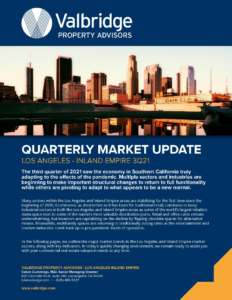3Q 2021: LA and Inland Empire
October 28, 2021
QUARTERLY MARKET UPDATE
LOS ANGELES-INLAND EMPIRE 3Q21
The third quarter of 2021 saw the economy in Southern California truly adapting to the effects of the pandemic. Multiple sectors and industries are beginning to make important structural changes to return to full functionality while others are pivoting to adapt to what appears to be a new normal.
Many sectors within the Los Angeles and Inland Empire areas are stabilizing for the first time since the beginning of 2020. E-commerce, as destructive as it has been for traditional retail, continues to buoy industrial sectors in both the Los Angeles and Inland Empire areas as some of the world’s largest retailers claim space next to some of the nation’s most valuable distribution ports. Retail and office rates remain underwhelming, but investors are capitalizing on the decline by flipping obsolete spaces for alternative means. Meanwhile, multifamily spaces are returning to traditionally strong rates as the entertainment and tourism industries crank back up to pre-pandemic levels of operation.

Below, we outline the major market trends in four critical Los Angeles and Inland Empire major market sectors, along with key indicators, download the PDF. In today’s quickly changing environment, we remain ready to assist you with your commercial real estate valuation needs at any time.
LOS ANGELES INDUSTRIAL REAL ESTATE TRENDS
- The Los Angeles industrial sector has remained a strong performer throughout the pandemic as local ports handle 78% of West Coast container volume and nearly a third of all imports to the U.S.
- Recent transactions with aerospace and defense companies are keeping industrial vacancies extremely low, remaining favorable to landlords for the foreseeable future.
- Asking rents are increasing well above the national rate at 7.5% compared to last year’s rate of 6.7%. This is a significant occurrence in submarkets where industrial users compete with other property types.
- Following last year’s $5.6 billion in volume, this year saw the third highest dollar volume ever for industrial transactions, at $5.4 billion.
INLAND EMPIRE INDUSTRIAL REAL ESTATE TRENDS
- Sales activity in the Inland Empire industrial sector has bounced back after temporarily pausing during the pandemic.
- Throughout the past year, net absorption has grown to 30.3 million SF, while rent has increased 10.8%.
- Demand for industrial space continues to rise as logistics and e-commerce companies continue to see explosive growth.
- A large portion of the industrial growth within the Inland Empire comes from large retailers like Amazon seeking larger spaces for new warehouses and distribution centers.
- Rent on logistics buildings with at least 200,000 SF are about 30% higher in the Inland Empire than in the rest of the nation.
LOS ANGELES OFFICE REAL ESTATE TRENDS
- The Los Angeles office space sector continues to see rising vacancies as rental rates continue to fall from the peak in 1Q20.
- This is the steadiest decline experienced by the office sector in nearly a decade, with a vacancy of nearly 9.3 million SF.
- Asking rates still remain above the national average at $41.00/ SF, but landlords will find difficulty pushing rental rates higher for the upcoming terms.
- Recently, investors have shown a willingness to keep their bets in the industrial sector despite the current downturn, and distressed properties remain few.
- The upcoming terms will determine the future of office space in not only the Los Angeles area, but also the nation. The rise in work-from-home culture has and will continue to change the nature and structure of office demand.
INLAND EMPIRE OFFICE REAL ESTATE TRENDS
- The Inland Empire office vacancy rate has remained steady throughout the year at 7.2% by serving local firms and government establishments.
- Overall rents have grown by 2.6% over the past year with the majority of the gains in areas with freeway access or proximity to desirable neighboring areas like Los Angeles and Orange counties.
- Market prices have grown 2.5% year-over-year as medical buildings continue to account for some of the largest transactions.
- Vacancies could potentially continue to rise as local companies continue to evaluate their office space needs throughout the upcoming terms.
LOS ANGELES RETAIL REAL ESTATE TRENDS
- The Los Angeles retail sector has had a strong quarter, with net absorption positive for the first time in two years and a sustained increase in gross leasing activity.
- Asking rents have declined to $33.00/SF since the pandemic, but remain at a steady 50% above the national average of $22.00SF.
- Los Angeles retail property seems largely immune from the widespread retail downturn of the pandemic, experiencing the highest sales volume in the country over the past 12 months, with sales volume totaling $4.7 billion.
- Average market cap rates for the retail sector, currently residing at 5.4%, are far below the national average of 7.0%.
INLAND EMPIRE RETAIL REAL ESTATE TRENDS
- The Inland Empire Retail sector is experiencing one of the highest vacancy rates in the nation as compared to other metro areas with populations over one million.
- Roughly 40% of the Inland Empire’s retail inventory is in neighborhood centers to serve local demand and consumers outside of the modest number of leisure travelers, and is suffering.
- Asking rents grew by 5% over the past 12 months, and the pace of job growth is expected to also rise.
- As more retail spaces become obsolete, developers who repurpose these facilities into mixed-use projects are continuing to show interest in the sector.
LOS ANGELES MULTIFAMILY HOUSING REAL ESTATE TRENDS
- After experiencing the worst conditions in a decade for the Los Angeles multifamily sector, the apartment market is seeing notable improvements.
- Vacancies have shown enormous improvement by dropping from the peak of 6% in 2020 to 3.8%.
- Asking rent rates have declined by 2.5%, with rates averaging around $2.46/SF at the end of 3Q21.
- Average market cap rates and average market pricing are both outperforming the national rate, with the market price holding at $380,000/unit and the market cap rate falling to 4.2%.
INLAND EMPIRE MULTIFAMILY HOUSING REAL ESTATE TRENDS
- Sales volume for the Inland Empire multifamily sector has increased by $400,000 over the last year, yet remains underneath pre-pandemic margins.
- Vacancies have fallen to 2.0%, with every other submarket remaining at 3.0%. Rent gains have increased by 14.8% over the past year.
- The market price for Inland Empire multifamily housing is growing faster than the national average with an increase of nearly 12% year over year.
- Market cap rates have been reported at 4.3%.
For more, including a deep dive into supply chain challenges, DOWNLOAD FULL REPORT HERE.


